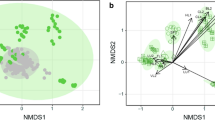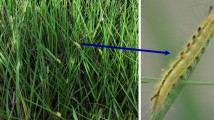Abstract
Due to global warming, species are expanding their range to higher latitudes. Some range expanding plants have become invasive in their new range. The Evolution of Increased Competitive Ability (EICA) hypothesis and the Shifting Defense Hypothesis (SDH) predict altered selection on plant defenses in the introduced range of invasive plants due to changes in herbivore pressures and communities. Here, we investigated chemical defenses (glucosinolates) of five native and seven invasive populations of the Eurasian invasive range expanding plant, Rorippa austriaca. Further, we studied feeding preferences of a generalist and a specialist herbivore among the populations. We detected eight glucosinolates in the leaves of R. austriaca. 8-Methylsulfinyloctyl glucosinolate was the most abundant glucosinolate in all plants. There were no overall differences between native and invasive plants in concentrations of glucosinolates. However, concentrations among populations within each range differed significantly. Feeding preference between the populations by a generalist herbivore was negatively correlated with glucosinolate concentrations. Feeding by a specialist did not differ between the populations and was not correlated with glucosinolates. Possibly, local differences in herbivore communities within each range may explain the differences in concentrations of glucosinolates among populations. Little support for the predictions of the EICA hypothesis or the SDH was found for the glucosinolate defenses of the studied native and invasive R. austriaca populations.



Similar content being viewed by others
References
Agerbirk N, Petersen BL, Olsen CE, Halkier BA, Nielsen JK (2001) 1,4-Dimethoxyglucobrassicin in Barbarea and 4-hydroxyglucobrassicin in Arabidopsis and Brassica. J Agric Food Chem 49:1502–1507
Bleeker W (2003) Hybridization and Rorippa austriaca (Brassicaceae) invasion in Germany. Mol Ecol 12:1831–1841
Blossey B, Nötzold R (1995) Evolution of increased competitive ability in invasive nonindigenous plants - a hypothesis. J Ecol 83:887–889
Bones AM, Rossiter JT (1996) The myrosinase-glucosinolate system, its organisation and biochemistry. Physiol Plant 97:194–208
Brown PD, Tokuhisa JG, Reichelt M, Gershenzon J (2003) Variation of glucosinolate accumulation among different organs and developmental stages of Arabidopsis thaliana. Phytochemistry 62:471–481
Buschmann H, Edwards PJ, Dietz H (2005) Variation in growth pattern and response to slug damage among native and invasive provenances of four perennial Brassicaceae species. J Ecol 93:322–334
Cano L, Escarre J, Vrieling K, Sans FX (2009) Palatability to a generalist herbivore, defence and growth of invasive and native Senecio species: testing the evolution of increased competitive ability hypothesis. Oecologia 159:95–106
Catford JA, Jansson R, Nilsson C (2009) Reducing redundancy in invasion ecology by integrating hypotheses into a single theoretical framework. Divers Distrib 15:22–40
Chen IC, Hill JK, Ohlemüller R, Davis DB, Thomas CD (2011) Rapid range shifts of species associated with high levels of climate warming. Science 333:1024–1026
Cipollini D, Mbagwu J, Barto K, Hillstrom C, Enright S (2005) Expression of constitutive and inducible chemical defenses in native and invasive populations of Alliaria petiolata. J Chem Ecol 31:1255–1267
Dietz H, Kohler A, Ullmann I (2002) Regeneration growth of the invasive clonal forb Rorippa austriaca (Brassicaceae) in relation to fertilization and interspecific competition. Plant Ecol 158:171–182
Dlugosch KM, Parker IM (2008) Invading populations of an ornamental shrub show rapid life history evolution despite genetic bottlenecks. Ecol Lett 11:701–709
Doorduin LJ, Vrieling K (2011) A review of the phytochemical support for the shifting defence hypothesis. Phytochem Rev 10:99–106
Engelkes T, Morrien E, Verhoeven KJF, Bezemer TM, Biere A, Harvey JA, McIntyre LM, Tamis WLM, van der Putten WH (2008) Successful range-expanding plants experience less above-ground and below-ground enemy impact. Nature 456:946–948
Engelkes T, Wouters B, Bezemer TM, Harvey JA, van der Putten WH (2012) Contrasting patterns of herbivore and predator pressure on invasive and native plants. Basic Appl Ecol 13:725–734
Felker-Quinn E, Schweitzer JA, Bailey JK (2013) Meta-analysis reveals evolution in invasive plant species but little support for Evolution of Increased Competitive Ability (EICA). Ecol Evol 3:739–751
Haeupler H, Schönfelder P (1989) Atlas der Farn-und Blütenpflanzen der Bundesrepublik Deutschland. Ulmer, Stuttgart
Haribal M, Renwick JAA (2001) Seasonal and population variation in flavonoid and alliarinoside content of Alliaria petiolata. J Chem Ecol 27:1585–1594
Harvey JA, van Dam NM, Raaijmakers CE, Bullock JM, Gols R (2011) Tri-trophic effects of inter- and intra-population variation in defence chemistry of wild cabbage (Brassica oleracea). Oecologia 166:421–431
Hopkins RJ, van Dam NM, van Loon JJA (2009) Role of glucosinolates in insect-plant relationships and multitrophic interactions. Annu Rev Entomol 54:57–83
Johansson AS (1951) The food plant preference of Pieris brassicae L. (Lepid. Pieridae). Norsk Ent Tidsskr 8:187–195
Joshi J, Vrieling K (2005) The enemy release and EICA hypothesis revisited: incorporating the fundamental difference between specialist and generalist herbivores. Ecol Lett 8:704–714
Keane RM, Crawley MJ (2002) Exotic plant invasions and the enemy release hypothesis. Trends Ecol Evol 17:164–170
Kudrna O, Harpke A, Lux K, Pennestorfer J, Schweiger O, Settele J, Wiemers W (2011) Distribution atlas of butterflies in Europe. Gesellschaft für Schmetterlingsschutz, Halle
Lakeman-Fraser P, Ewers RM (2013) Enemy release promotes range expansion in a host plant. Oecologia 172:1203–1212
Lankau RA (2007) Specialist and generalist herbivores exert opposing selection on a chemical defense. New Phytol 175:176–184
Lankau RA, Strauss SY (2007) Mutual feedbacks maintain both genetic and species diversity in a plant community. Science 317:1561–1563
Linhart YB, Grant MC (1996) Evolutionary significance of local genetic differentiation in plants. Annu Rev Ecol Syst 27:237–277
Macel M, Bruinsma M, Dijkstra SM, Ooijendijk T, Niemeyer HM, Klinkhamer PGL (2005) Differences in effects of pyrrolizidine alkaloids on five generalist insect herbivore species. J Chem Ecol 31:1493–1508
Mauricio R, Rausher MD (1997) Experimental manipulation of putative selective agents provides evidence for the role of natural enemies in the evolution of plant defense. Evolution 51:1435–1444
Morrien E, Engelkes T, Macel M, Meisner A, Van der Putten WH (2010) Climate change and invasion by intracontinental range-expanding exotic plants: the role of biotic interactions. Ann Bot 105:843–848
Müller C, Martens N (2005) Testing predictions of the ‘evolution of increased competitive ability’ hypothesis for an invasive crucifer. Evol Ecol 19:533–550
Müller-Schärer H, Schaffner U, Steinger T (2004) Evolution in invasive plants: implications for biological control. Trends Ecol Evol 19:417–422
Parmesan C, Yohe G (2003) A globally coherent fingerprint of climate change impacts across natural systems. Nature 421:37–42
Popova TA (1993) A study of antibiotic effects of cabbage cultivars on the cabbage moth Mamestra brassicae L. (Lepidoptera, Noctuidae). Entomol Rev 72:125–132
Renwick JA, Radke C, Sachdev-Gupta K, Städler E (1992) Leaf surface chemicals stimulating oviposition by Pieris rapae (Lepidoptera: Pieridae) on cabbage. Chemoecology 3:33–38
Sakai AK, Allendorf FW, Holt JS, Lodge DM, Molofsky J, With KA, Baughman S, Cabin RJ, Cohen JE, Ellstrand NC, McCauley DE, O’Neil P, Parker IM, Thompson JN, Weller SG (2001) The population biology of invasive species. Annu Rev Ecol Syst 32:305–332
Salazar D, Marquis RJ (2012) Herbivore pressure increases toward the equator. Proc Natl Acad Sci U S A 109:12616–12620
Schoonhoven LM, van Loon JJA, Dicke M (2005) Insect-plant biology. Oxford University Press, Oxford
Siemens DH, Mitchell-Olds T (1998) Evolution of pest-induced defenses in Brassica plants: tests of theory. Ecology 79:632–646
Strauss SY, Webb CO, Salamin N (2006) Exotic taxa less related to native species are more invasive. Proc Natl Acad Sci U S A 103:5841–5845
Textor S, Gershenzon J (2009) Herbivore induction of the glucosinolate-myrosinase defense system: major trends, biochemical bases and ecological significance. Phytochem Rev 8:149–170
Van der Meijden E (1996) Plant defence, an evolutionary dilemma: contrasting effects of (specialist and generalist) herbivores and natural enemies. Entomol Exp Appl 80:307–310
Van der Putten WH, Macel M, Visser ME (2010) Predicting species distribution and abundance responses to climate change: why it is essential to include biotic interactions across trophic levels. Phil Trans R Soc B 365:2025–2034
van Leur H, Vet LEM, Van der Putten WH, van Dam NM (2008) Barbarea vulgaris glucosinolate phenotypes differentially affect performance and preference of two different species of lepidopteran herbivores. J Chem Ecol 34:121–131
Wittstock U, Agerbirk N, Stauber EJ, Olsen CE, Hippler M, Mitchell-Olds T, Gershenson J, Vogel H (2004) Successful herbivore attack due to metabolic diversion of a plant chemical defense. Proc Natl Acad Sci U S A 101:4859–4864
Wolf VC, Berger U, Gassmann A, Müller C (2011) High chemical diversity of a plant species i accompanied by increased chemical defence in invaisve populations. Biol Invasions 13:2091–2102
Wolfe LM, Elzinga JA, Biere A (2004) Increased susceptibility to enemies following introduction in the invasive plant Silene latifolia. Ecol Lett 7:813–820
Zangerl AR, Berenbaum MR (2005) Increase in toxicity of an invasive weed after reassociation with its coevolved herbivore. Proc Natl Acad Sci U S A 102:15529–15532
Zou JW, Rogers WE, Siemann E (2008) Increased competitive ability and herbivory tolerance in the invasive plant Sapium sebiferum. Biol Invasions 10:291–302
Züst T, Heichinger C, Grossniklaus U, Harrington R, Kliebenstein DJ, Turnbull LA (2012) Natural enemies drive geographic variation in plant defenses. Science 338:116–119
Acknowledgments
We thank the Center for Plant Molecular Biology (ZMBP) of the University of Tübingen for the use of their greenhouse and laboratory facilities. Zuzana Münzbergova kindly provided the Czech plant material. We thank Karin Djendouci, Bielefeld University, for assistance with the glucosinolate extraction and two anonymous referees for comments on the manuscript.
Author information
Authors and Affiliations
Corresponding author
Additional information
An erratum to this article can be found at http://dx.doi.org/10.1007/s10886-016-0773-0.
Rights and permissions
About this article
Cite this article
Huberty, M., Tielbörger, K., Harvey, J.A. et al. Chemical Defenses (Glucosinolates) of Native and Invasive Populations of the Range Expanding Invasive Plant Rorippa austriaca . J Chem Ecol 40, 363–370 (2014). https://doi.org/10.1007/s10886-014-0425-1
Received:
Revised:
Accepted:
Published:
Issue Date:
DOI: https://doi.org/10.1007/s10886-014-0425-1




